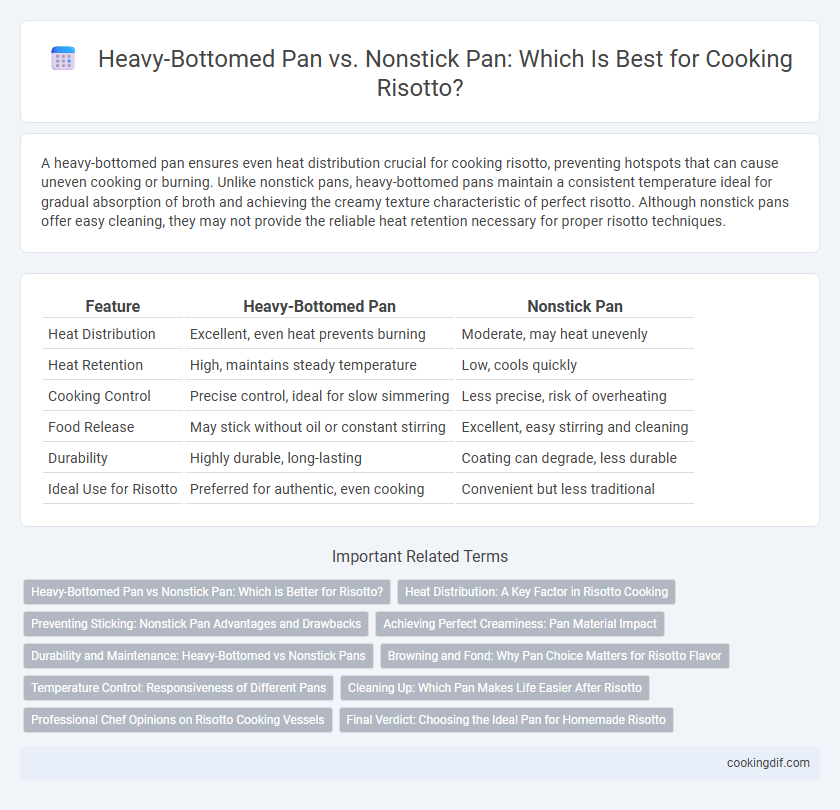A heavy-bottomed pan ensures even heat distribution crucial for cooking risotto, preventing hotspots that can cause uneven cooking or burning. Unlike nonstick pans, heavy-bottomed pans maintain a consistent temperature ideal for gradual absorption of broth and achieving the creamy texture characteristic of perfect risotto. Although nonstick pans offer easy cleaning, they may not provide the reliable heat retention necessary for proper risotto techniques.
Table of Comparison
| Feature | Heavy-Bottomed Pan | Nonstick Pan |
|---|---|---|
| Heat Distribution | Excellent, even heat prevents burning | Moderate, may heat unevenly |
| Heat Retention | High, maintains steady temperature | Low, cools quickly |
| Cooking Control | Precise control, ideal for slow simmering | Less precise, risk of overheating |
| Food Release | May stick without oil or constant stirring | Excellent, easy stirring and cleaning |
| Durability | Highly durable, long-lasting | Coating can degrade, less durable |
| Ideal Use for Risotto | Preferred for authentic, even cooking | Convenient but less traditional |
Heavy-Bottomed Pan vs Nonstick Pan: Which is Better for Risotto?
A heavy-bottomed pan offers superior heat distribution and retention, essential for achieving the creamy texture characteristic of risotto, while a nonstick pan can hinder the development of the fond necessary for flavor depth. Heavy-bottomed pans, typically made of stainless steel or cast iron, prevent hot spots and ensure even cooking, which is crucial for slowly releasing starches from arborio rice. Nonstick surfaces may impede the proper stirring and toasting process, resulting in a less authentic risotto experience.
Heat Distribution: A Key Factor in Risotto Cooking
A heavy-bottomed pan ensures even heat distribution, crucial for the slow, consistent cooking risotto demands, preventing hotspots that can scorch the rice. Nonstick pans often have thinner bases, causing uneven heat and increased risk of burning or undercooking parts of the dish. Consistent heat control in a heavy-bottomed pan enhances the creamy texture and optimal starch release essential to perfect risotto.
Preventing Sticking: Nonstick Pan Advantages and Drawbacks
Nonstick pans offer a smooth cooking surface that significantly reduces the risk of risotto sticking, promoting easier stirring and cleanup. However, nonstick coatings may not tolerate high heat as well as heavy-bottomed pans, potentially affecting the even cooking essential for authentic risotto texture. While heavy-bottomed pans distribute heat more consistently, their tendency to cause sticking requires careful attention and frequent stirring to prevent burning.
Achieving Perfect Creaminess: Pan Material Impact
A heavy-bottomed pan ensures even heat distribution essential for cooking risotto, preventing hot spots that can cause uneven starch release and affect creaminess. Nonstick pans, while reducing sticking, often deliver inconsistent heat, which may lead to less optimal texture and uneven cooking. Choosing a heavy-bottomed pan enhances the gradual absorption of broth, crucial for achieving the signature velvety, creamy consistency of perfectly cooked risotto.
Durability and Maintenance: Heavy-Bottomed vs Nonstick Pans
Heavy-bottomed pans offer superior durability, with their thick construction resisting warping and lasting for decades under high heat, ideal for the consistent temperature control risotto requires. Nonstick pans, while easier to clean and requiring less oil, tend to wear down faster due to coating degradation and are more susceptible to scratches, necessitating careful maintenance to preserve nonstick properties. Opting for heavy-bottomed pans ensures robust performance and longevity, reducing the need for frequent replacement in risotto preparation.
Browning and Fond: Why Pan Choice Matters for Risotto Flavor
A heavy-bottomed pan ensures even heat distribution crucial for achieving the perfect risotto browning and rich fond development, which directly enhances flavor complexity. Nonstick pans hinder fond formation due to their slick surface, preventing the caramelization and Maillard reactions essential for depth and texture. Choosing a heavy-bottomed vessel optimizes heat retention and promotes the savory crust that defines authentic risotto taste.
Temperature Control: Responsiveness of Different Pans
Heavy-bottomed pans provide superior temperature control and even heat distribution, essential for preventing risotto from scorching or sticking during the slow cooking process. Nonstick pans heat up quickly but often lack consistent heat retention, causing fluctuations that can disrupt the gradual absorption of broth critical for perfect risotto texture. The thermal mass of heavy-bottomed cookware ensures stable simmering, allowing precise responsiveness to heat adjustments needed for creamy, evenly cooked risotto grains.
Cleaning Up: Which Pan Makes Life Easier After Risotto
Heavy-bottomed pans often require more effort to clean due to their thicker material retaining food residue and oils, especially after cooking creamy risotto. Nonstick pans significantly simplify cleanup by preventing rice from sticking, enabling quick washing with minimal scrubbing. Choosing a nonstick pan can save time and reduce post-cooking stress when preparing risotto.
Professional Chef Opinions on Risotto Cooking Vessels
Professional chefs typically prefer heavy-bottomed pans for cooking risotto due to their superior heat distribution, which ensures even cooking and prevents hot spots that can cause sticking or burning. Heavy-bottomed pans made of materials like stainless steel or copper provide the consistent temperature control crucial for the gradual liquid absorption process in risotto. Nonstick pans are less favored in professional kitchens as they often lack the necessary heat tolerance and may interfere with the development of the desired creamy texture through proper stirring and toasting.
Final Verdict: Choosing the Ideal Pan for Homemade Risotto
Heavy-bottomed pans provide even heat distribution essential for the gentle simmering of risotto, preventing hot spots that can cause uneven cooking or burning. Nonstick pans offer easier cleanup and reduce the risk of rice sticking but may not deliver the same depth of flavor due to less efficient heat conduction. For homemade risotto, a heavy-bottomed pan is generally preferred to achieve optimal texture and caramelization, ensuring a creamy and perfectly cooked dish.
Heavy-bottomed pan vs nonstick pan for cooking vessel Infographic

 cookingdif.com
cookingdif.com